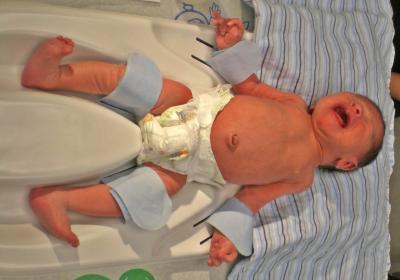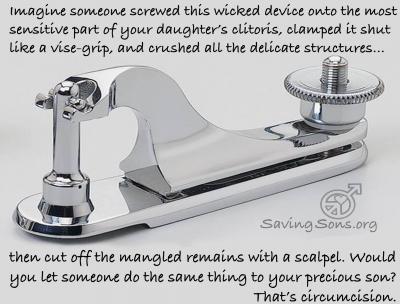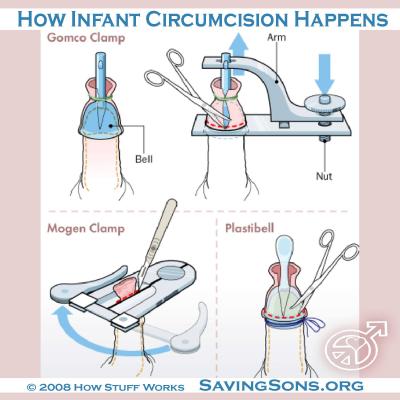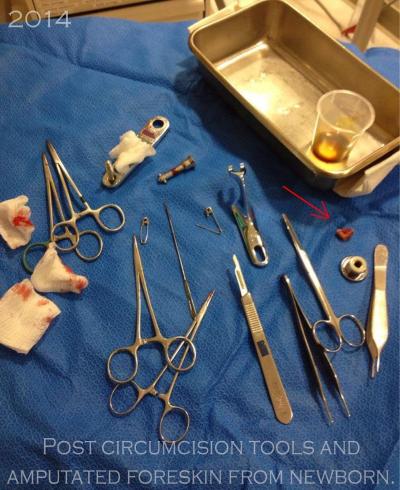Restraint
"...In less than 30 seconds, professionals can immobilize the infant securely . . . on the principle of positive 4-point restraint. . . . [The Circumstraint] positions the infant with the hips elevated, presenting the genitalia. The platform between the infant's legs provides support for a circumcision clamp..."
From the Circumstraint's actual product description.
When a circumcision is performed on an infant, the first step is usually to tightly "secure" the child's body, and there is actually a specially-designed medical device for this purpose. It is called a Circumstraint. With a baby-shaped depression and four straps, this device allows the baby's legs - and arms too if necessary - to be restrained during the procedure.
The circumstraint product description reads like the instructions for a torture device. Ironically, this restraining is done for the "safety" of the child, to prevent accidental injury from unexpected movements. Wouldn't an even safer solution be not having a knife and clamp near his penis at all?
Clamps
There are a variety of clamp devices a doctor can choose, each having their drawbacks and "advantages." The most common are the Gomco Clamp, the Mogen Clamp, the PlastiBell, and less commonly in the U.S. is the PrePex device. Of course there are other tools used alongside each of these, including forceps, hemostats, scissors, scalpels, and so on.
Steps involved
Depending on the clamping device being used, the exact procedures are slightly different. But the basic steps are essentially the same in most instances.
- First the foreskin must be separated from the glans. As the boy's body is developing in the mother's womb, the foreskin is initially fused to the glans of the penis, similar to how fingernails are fused to the underlying finger. This adhesive membrane will naturally break down and allow the foreskin to separate on its own, but this typically does not happen for several years. Thus, in order for the foreskin to be removed, this adhesion must first be forcibly separated by inserting a blunt probe under the foreskin and blindly sweeping it full circle around the glans. Obviously this is very painful -- imagine something being shoved under your fingernail until it pops off.
- Next, a line down the foreskin needs to be crushed and cut. Even after the foreskin is separated, its opening is usually too narrow for the inner part of the clamp to be inserted. A "dorsal slit" needs to be cut into the foreskin to allow the device to fit, but before that cut is made, the area is crushed with a hemostat to minimize bleeding. Of course this is very painful -- imagine a pair of pliers pinching/crushing even just a small part of your genital skin.
- Then, the clamp is inserted, positioned, and squeezed together. This crushes a line all around the base of the foreskin, to reduce bleeding where the final cut will eventually be made. Often the clamp is left attached to the baby's penis, clamping down on the foreskin, for several minutes.
- Finally, the foreskin is cut away and device removed. After several minutes of crushing the blood vessels, the foreskin is cut away with a scalpel and the clamping device is removed.
Differences in steps based on device: The Mogen clamp does the crushing and cutting as one step but is more of a cutting than a crushing, and it cuts in a straight line (usually top-to-bottom) on the foreskin rather than circular. The PlastiBell and PrePex devices are installed and left in the closed (clamping) position for several days until the foreskin is essentially strangled, dies and falls off. Also, the PlastiBell and Prepex devices are inaccurately advertised as "non-cutting" or "bloodless" methods, but when used on an infant they still utilize the probe to rip the foreskin from the glans and a cut to make the initial dorsal slit to widen the foreskin opening.
You might hear the term "partial circumcision" come up in conversation. There is nothing "partial" to this process - if a child's penis is being circumcised, it is being circumcised. Some circumcisions are loose, and some are tight, but they all cause damage to the natural male anatomy.
Pain Management
Make no mistake, circumcisions are extremely painful. Depending on the doctor, the pain management techniques being utilized can be either non-existent or inadequate for the level of trauma involved. Regardless, even if the procedure could be made completely pain free, it still does not address the risk of immediate/future complications, nor does it address the ethics of subjecting a non-consenting person to a cosmetic surgery.
Video
Finally, to get the best understanding of how a circumcision is performed, watch a video of one happening. This video is narrated by the doctor performing the operation using a Gomco Clamp. Notice how he completely disregards the babies extremely distressed screams, and essentially dismisses the father's concern about pain relief.
(Video hosted at veoh.com.)




